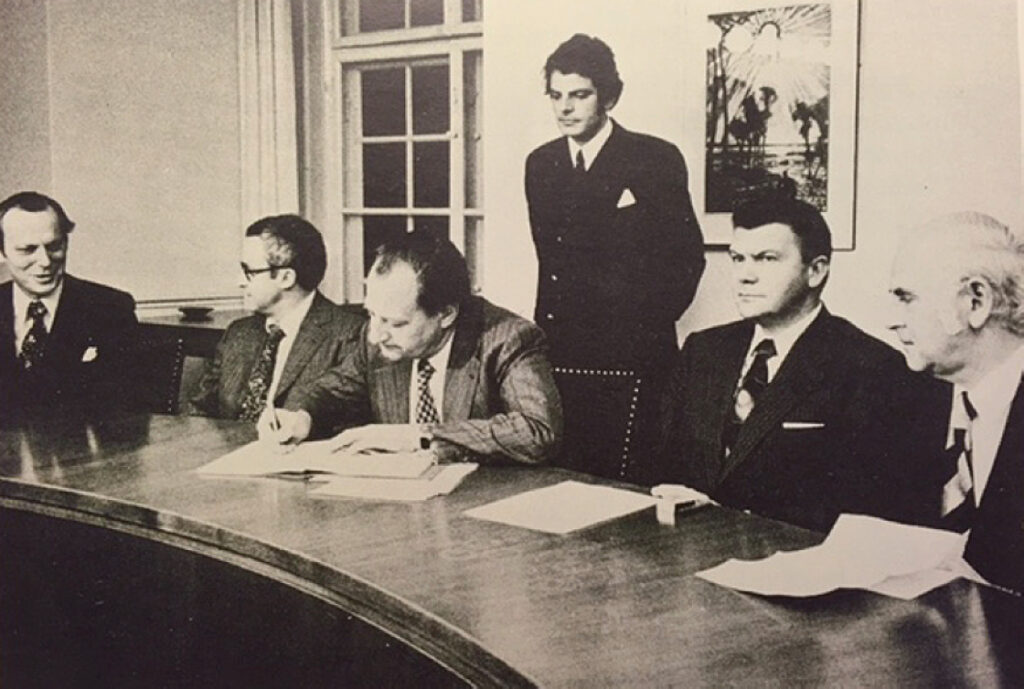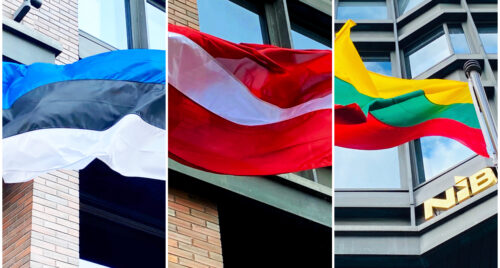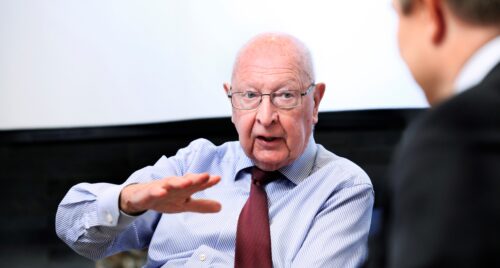Our history

1975
The agreement for the establishment of the Nordic Investment Bank (NIB) was signed in Copenhagen on 4 December 1975 by representatives of Denmark, Finland, Iceland, Norway and Sweden, from the left: Minister of Justice Kristian Gestrin, Finland; Minister of Finance Kjell-Olof Feldt, Sweden; Foreign Minister Ivar Nørgaard, Denmark; Church and Education Minister Bjartmar Gjerde, Norway; and Iceland’s Ambassador to Denmark, Sigurður Bjarnason.
1976
Operations begin in August, after Denmark, Finland, Iceland, Norway and Sweden decided in 1975 to set up the Nordic Investment Bank to promote economic growth and cooperation between the Nordic countries.
Bert Lindström (Sweden) becomes the first president of NIB.
NIB signs its first loan agreement.
1977
NIB is introduced on the international capital market with a eurodollar loan of USD 40 million.
1981
NIB moves into its new office at Unioninkatu 30, Helsinki.
1982
NIB is awarded the top credit rating, AAA/Aaa, for its long-term bonds.
1983
NIB agrees on its first project investment loan outside the membership area.
1984
Authorised capital doubles to SDR 800 million, loan authorisation to SDR 2,000 million. NIB employs 51 persons.
1986
Jannik Lindbæk (Norway) becomes NIB’s president.
1989
The Nordic Development Fund (NDF) is established. NIB starts focusing on environmental projects.
1990
The Nordic Environment Finance Corporation (NEFCO) is established a special unit within NIB. NEFCO separated from NIB in 1993.
1992
NIB participates in the Baltic Investment Programme, set up by the Nordic countries with the aim of helping to build up the private sector in the Baltic countries.
1993
NIB moves into the office building at Fabianinkatu 34, Helsinki. NIB purchased the property in 1996, and it serves as NIB’s main headquarters to this date.
1994
Project investment loans outside the member countries are paid to the private sector for the first time.
Jón Sigurðsson (Iceland) becomes NIB’s president.
1997
New loan facility established for environmental investment loans to projects on the areas adjacent to the member countries.
1999
A new Agreement on NIB and a headquarters agreement acknowledge the Bank’s multilateral status. NIB’s authorised capital is raised to EUR 4,000 million.
2004
NIB expands loan facilities for projects outside the member countries and for environmental projects.
2005
Estonia, Latvia and Lithuania become members of NIB. The authorised capital is increased to EUR 4,142 million.
Johnny Åkerholm (Finland) becomes NIB’s president.
2006
NIB renews its strategy and introduces the mandate to sharpen the focus on the sustainable growth of the member countries.
2008
NIB allocates EUR 1,500 million for lending facilities earmarked for climate change mitigation and the improvement of the Baltic Sea environment.
2011
NIB issues its first green bond under the new Environmental Bond framework.
NIB’s authorised capital is increased to EUR 6,142 million.
2012
Henrik Normann (Denmark) becomes NIB’s president.
2014
The Board of Directors conducts a comprehensive review of NIB’s strategy. The Bank issues its inaugural benchmark environmental bond.
2015
NIB establishes an Arctic lending facility.
2016
A special lending facility is allocated to invest in green bonds issued by companies and municipalities in the member countries.
2018
NIB renews its mandate rating framework with a focus on improving productivity and the environment in the member countries.
2020
NIB updates its Statutes to strengthen the Bank’s operations and ensure continued adherence to sound banking principles.
The Bank launches coronavirus response by issuing NIB Response Bonds and providing swift loans to alleviate the effects of the pandemic.
2021
André Küüsvek (Estonia) becomes NIB’s president.
NIB reviews its strategy to further accelerate delivery of the Bank’s mission.
2023
NIB opens a regional office in Riga to bring the Bank closer to its Baltic stakeholders.
2024
Governors invite NIB to strengthen regional resilience. NIB answers the call by reviewing its Sustainability Policy to allow security and resilience investments.
NIB signs a host country agreement with Latvia.
2025
NIB celebrates 50 years since the establishment and 20 years of the Baltic membership at the Bank.
Close to 50 years ago, NIB was established to promote economic growth and cooperation between the Nordic countries. Since the start of operations, the Baltic countries have joined the Bank as members. During the years, NIB has financed over 2,200 investment projects around the world, thereby contributing to business cooperation, investing activity and the prosperity of the member countries. Read more about the Bank’s history from the related articles and stories.

